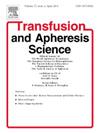中低收入国家浓缩血小板的细菌污染:来自一家三级医院的数据
IF 1.4
4区 医学
Q4 HEMATOLOGY
引用次数: 0
摘要
背景输注受细菌污染的血小板可能会导致受血者发生危及生命的败血症。血小板筛查的成本是中低收入国家(LMICs)面临的一大挑战。在这项研究中,我们评估了巴基斯坦一家研究所的血小板单位(PU)中细菌污染的频率以及向患者输注此类血小板的结果。材料和方法在 2018-2022 年期间,使用 BacT-ALERT® 自动系统筛查了全血血小板(WB-PU)和分离血小板(AP)。在采集后 24 小时内,将每个 AP 的单个样本和≤5 个 WB-PU 的样本集中起来并进行培养。出现初始阳性信号后,进行再次培养、革兰氏染色、池解析和细菌鉴定。结果共筛查出 84246 个 PU(476 个 AP 和 83770 个 WB-PU),第一天有 239 个(0.28%)培养瓶呈阳性。对 1378 个 PU(239 个培养瓶)进行了单个培养,以解决集合问题。1378 个 PU 中有 7 个(0.5%)"确认阳性",1371 个(99.4%)"不确定"。在 84246 瓶(98.3%)中,有 82868 瓶(82392 瓶 WB-PU 和 476 瓶 AP)未观察到细菌生长。总体细菌污染率较低,约为 12000 个 PU 中有 1 个受到污染。七名患者输注了受污染的 PU,但未观察到输血反应。低收入国家需要成本低、效率高的技术来筛查血小板中是否存在细菌。本文章由计算机程序翻译,如有差异,请以英文原文为准。
Bacterial contamination of platelets concentrates in a lower middle-income country: Data from a single tertiary care hospital
Background
Transfusion of bacterially contaminated platelets may cause life threatening sepsis in the recipients. Cost of platelet screening is a major challenge for low middle income countries (LMICs). In this study, we evaluated the frequency of bacterial contamination in the platelet units (PUs) and the outcome of transfusing such platelets to the patients in a single institute at Pakistan.
Material and methods
During 2018–2022, whole blood-derived (WB-PU) and apheresis platelets (AP) were screened by BacT-ALERT® automated system. Single sample from each AP and samples from ≤ 5 WB-PUs were pooled and cultured within 24 h-post collection. An initial positive signal was followed by re-culture, Gram’s staining, pool resolution and bacterial identification. Results were interpreted as ‘confirmed positive’ or ‘indeterminate’ and ‘confirmed negative’ based on differences in initial-reactive and final results.
Results
A total of 84246 PUs (476 AP and 83770 WB-PU) was screened, and 239 (0.28 %) culture bottles were positive on day one. Individual cultures were performed on 1378 PUs (239 bottles) for pool resolution. Seven of 1378 (0.5 %) PUs were ‘confirmed positive’ while 1371 (99.4 %) were ‘indeterminate’. No bacterial growth was observed in 82868 (82392 WB-PU and 476 AP) of 84246 (98.3 %). Overall bacterial contamination rate was low at 1 in 12000 PUs approximately. Seven patients were transfused with contaminated PUs but no transfusion reaction was observed.
Conclusion
An insignificant risk of bacterial contamination was observed in this study but remains a concern for patient safety. LMICs need cost effective but efficient techniques to screen platelets for the presence of bacteria.
求助全文
通过发布文献求助,成功后即可免费获取论文全文。
去求助
来源期刊
CiteScore
3.60
自引率
5.30%
发文量
181
审稿时长
42 days
期刊介绍:
Transfusion and Apheresis Science brings comprehensive and up-to-date information to physicians and health care professionals involved in the rapidly changing fields of transfusion medicine, hemostasis and apheresis. The journal presents original articles relating to scientific and clinical studies in the areas of immunohematology, transfusion practice, bleeding and thrombotic disorders and both therapeutic and donor apheresis including hematopoietic stem cells. Topics covered include the collection and processing of blood, compatibility testing and guidelines for the use of blood products, as well as screening for and transmission of blood-borne diseases. All areas of apheresis - therapeutic and collection - are also addressed. We would like to specifically encourage allied health professionals in this area to submit manuscripts that relate to improved patient and donor care, technical aspects and educational issues.
Transfusion and Apheresis Science features a "Theme" section which includes, in each issue, a group of papers designed to review a specific topic of current importance in transfusion and hemostasis for the discussion of topical issues specific to apheresis and focuses on the operators'' viewpoint. Another section is "What''s Happening" which provides informal reporting of activities in the field. In addition, brief case reports and Letters to the Editor, as well as reviews of meetings and events of general interest, and a listing of recent patents make the journal a complete source of information for practitioners of transfusion, hemostasis and apheresis science. Immediate dissemination of important information is ensured by the commitment of Transfusion and Apheresis Science to rapid publication of both symposia and submitted papers.

 求助内容:
求助内容: 应助结果提醒方式:
应助结果提醒方式:


